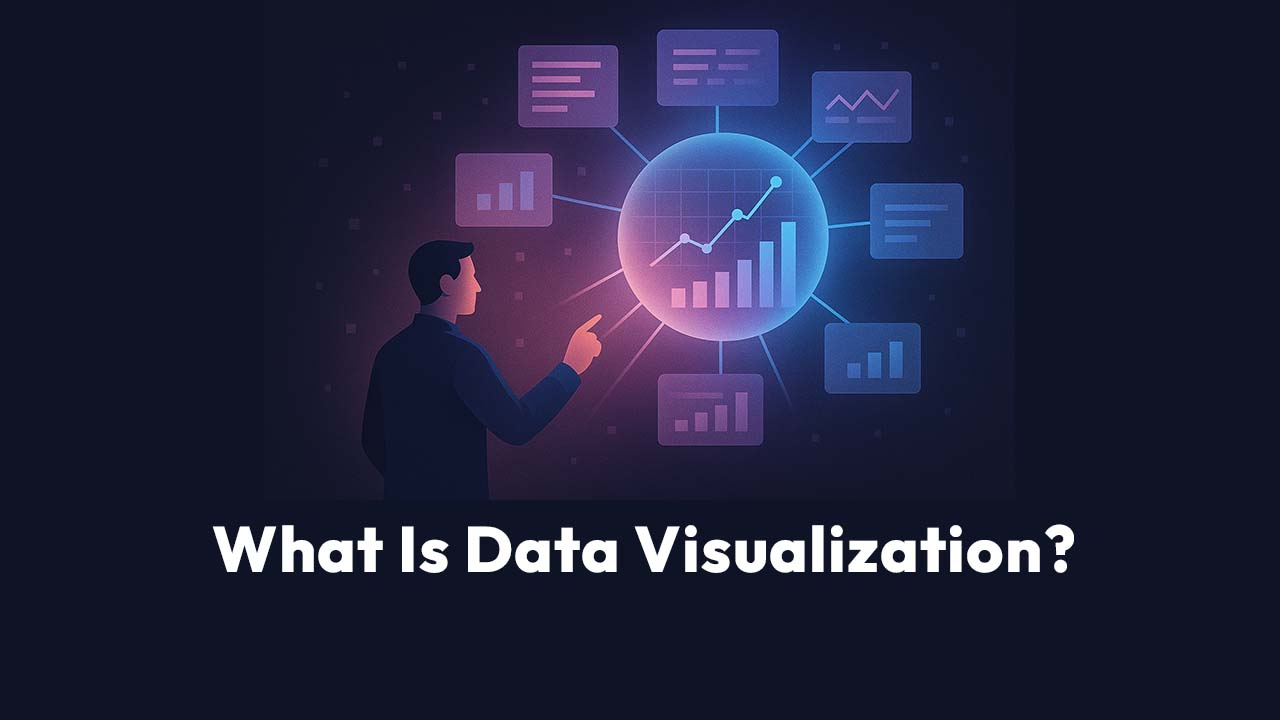The Bridge Between Data and Decision-Making
Data visualization is the process of turning complex data into visual insights (using charts, dashboards, and maps) to help teams identify trends, track performance, and make faster, more informed decisions.
It’s not just about pretty graphics.
It’s about clarity, action, and alignment across every level of your business operations.
Why Every Operations Team Needs Data Visualization Now
Think about your daily standups or executive meetings.
How much of the discussion centers around numbers—sales figures, on-time delivery rates, supply chain costs, customer satisfaction scores?
Now imagine trying to explain all that through spreadsheets alone.
It’s slow. It’s painful. It’s easy to misinterpret.
That’s why data visualization has become an essential operational discipline—not just a reporting feature. It’s the tool that lets you see how your business is performing in real time, spot bottlenecks before they escalate, and communicate performance across teams that don’t speak in SQL or pivot tables.
According to the Wharton School of Business, people process visuals 60,000 times faster than text. That means a single well-designed dashboard can convey what would take pages of numbers to explain.
What Data Visualization Really Is?
At its core, data visualization is the graphical representation of data using visual elements like charts, graphs, maps, and dashboards.
It translates abstract numbers into concrete patterns you can interpret instantly.
When done right, data visualization bridges two worlds: raw analytics and human understanding. It’s the final stage of the data pipeline—the point where insight becomes visible. For operations teams, this is where “data-driven” stops being a buzzword and starts driving actual performance.
Let’s say you manage logistics for a nationwide distributor. Every morning, you’re flooded with data: shipment times, warehouse capacity, fuel costs, delivery delays. A line chart might reveal rising costs, but a map overlay might show where those costs spike—say, in a specific region affected by weather or traffic patterns.
That’s the magic of visualization: it turns raw numbers into operational foresight.
How Does Data Visualization Work?
Data visualization works by taking structured or unstructured data, cleaning and transforming it, and then displaying it in a visual format that reveals relationships, patterns, or anomalies.
It starts with data ingestion—pulling information from your systems (ERP, CRM, HR, or IoT sensors). Then comes data transformation, where inconsistencies are removed, metrics standardized, and dimensions defined.
Finally, visualization tools like Tableau, Power BI, or Qlik display that data through dashboards that can be filtered, sliced, or drilled down interactively.
In operations, this means moving beyond static monthly reports to real-time dashboards. Imagine watching order volume rise in one region and seeing inventory depletion in another—all on the same screen. That’s not just data—it’s operational intelligence at work.
What Are the Types of Data Visualization?
There are many types of data visualization, from basic charts to complex dashboards.
The best type depends on what question you’re trying to answer.
Common Visualization Types
Don’t just visualize data for the sake of aesthetics—visualize to answer a question.
- “Which process is slowing down production?”
- “Where are we leaking revenue?”
- “Which region delivers the best margins?”
Your visualization choice should align directly with the business question you’re trying to solve.
Why Is Data Visualization Important in Business Operations?
Because decisions made from visuals are faster, clearer, and more accurate.
Data visualization helps operations teams identify inefficiencies, monitor KPIs, and align cross-functional goals.
Operations is about movement—of goods, people, money, and information. But movement without visibility is chaos. Data visualization gives teams that visibility, so they can see cause and effect in real time.
Let’s look at some examples:
- In supply chain: A logistics manager uses a heat map to detect warehouse congestion. Instead of waiting for monthly reports, they redirect shipments proactively.
- In HR operations: A staffing dashboard reveals that overtime costs spike in one department. The insight triggers a staffing model adjustment before burnout sets in.
- In finance operations: A real-time dashboard shows invoice aging, helping CFOs anticipate cash flow bottlenecks.
In every case, visual data creates operational agility.
What Data Visualization Does That Raw Data Can’t
Raw data tells you what happened. Visualization shows you why it happened and what to do next.
A spreadsheet with 20,000 rows of data might hide critical anomalies. A scatter plot can expose them instantly. Humans excel at recognizing patterns visually. That’s why data visualization unlocks operational insight that traditional reports can’t.
Example:
Imagine you manage an e-commerce warehouse.
Your table of daily order data looks fine—until you plot it on a heat map and realize that delays spike on weekends, right when your staffing dips. Visualization doesn’t just describe problems—it reveals them.
What Are the Benefits of Data Visualization for Operations Teams?
Data visualization transforms how operations teams analyze, communicate, and act on data, leading to faster decisions, better collaboration, and measurable efficiency gains.
1. Faster Decision-Making
Visualization eliminates the cognitive friction of reading endless reports. You see outliers, shifts, and gaps immediately. When a dashboard updates in real time, managers respond in minutes instead of days.
2. Improved Cross-Team Communication
Charts bridge the gap between technical and non-technical staff. The warehouse manager, the finance lead, and the CEO can look at the same dashboard and interpret it the same way.
3. Pattern Recognition
Humans are wired for pattern detection. Visualization leverages that instinct, helping you catch seasonal trends, anomalies, and risks.
4. Accountability and Transparency
When KPIs are visualized and shared, accountability skyrockets. Teams align on the same source of truth.
5. Cost Optimization
Operational inefficiencies—like redundant inventory or production downtime—become glaringly obvious once visualized. What was once hidden in cells becomes visible in color-coded clarity.
How to Implement Data Visualization in Your Business Operations
Implementing data visualization requires clear objectives, reliable data sources, and the right visualization tools.
Step-by-Step Process
- Define Your Goals
What decisions do you want to improve? Tracking daily shipments? Forecasting staffing? Define your operational questions first. - Audit Your Data Sources
Integrate systems—ERP, CRM, finance, HR, IoT—to ensure your visualizations pull from clean, consistent data. - Choose the Right Tool
Tools like Tableau, Power BI, Qlik Sense, and Domo are popular because they connect directly to operational data and support real-time dashboards. - Design with Purpose
Follow the “less is more” rule. Use consistent color schemes, clear legends, and contextual labels. Avoid visual clutter. - Enable Interactivity
Filters, drill-downs, and hover-over tooltips let users explore data intuitively without needing SQL queries. - Train Your Team
Visualization is only powerful if your team understands how to interpret it. Invest in data literacy training.
A successful implementation isn’t about dashboards alone—it’s about culture. Encourage teams to start every meeting with visuals, not numbers. Make “show me the data” a standard operating practice.
What Are Common Data Visualization Mistakes (and How to Avoid Them)?
Common mistakes include overcomplicating visuals, using misleading scales, ignoring context, and choosing the wrong chart type.
Operations leaders often fall into the “more is better” trap—packing dashboards with every available metric. That’s noise, not insight.
How to Avoid Mistakes
- Simplify: Focus on 3–5 core KPIs per dashboard.
- Contextualize: Always include time frames, benchmarks, or targets.
- Be Accurate: Never manipulate axes or colors to exaggerate results.
- Be Accessible: Use color palettes that accommodate colorblind users and responsive designs for mobile views.
Exploratory vs. Explanatory Visualization: What’s the Difference?
Exploratory visualizations help analysts discover insights. Explanatory visualizations communicate those insights to others.
Exploratory visuals are dynamic—they invite “what if” questions. You might filter data, zoom into anomalies, or change variables.
Explanatory visuals, on the other hand, are static or semi-interactive—they guide the viewer toward a specific conclusion.
Example
- Exploratory: An operations analyst filters logistics data to find why delivery delays are increasing.
- Explanatory: That same analyst presents a chart in the executive meeting showing a 20% delay spike due to one supplier.
Both are vital. One fuels discovery; the other drives action.
What Data Visualization Tools Should Operations Teams Consider?
The right data visualization tool depends on your team’s technical ability, integration needs, and scalability goals.
If your organization already uses Microsoft 365, Power BI's integration makes adoption frictionless. If you need governance and real-time updates, Domo shines. For complex multi-source data blending, Qlik and Tableau are leaders. When operations teams need to investigate why metrics changed—not just see that they changed—Scoop Analytics delivers root cause analysis through natural language, enabling any team member to run ML-powered investigations using familiar spreadsheet concepts.
How Data Visualization Transforms Operational Culture
Data visualization transforms operational culture by replacing opinions with evidence, silos with collaboration, and confusion with shared clarity.
Imagine your daily operations meeting without finger-pointing or guesswork.
Instead, you pull up a dashboard showing metrics everyone agrees on—updated in real time.
The conversation shifts from “What happened?” to “What should we do next?”
That’s why many organizations now talk about “data democratization”—making data accessible across roles, not just IT. Visualization is the key that unlocks it.
How Does Data Visualization Support Decision-Making?
It supports decision-making by helping teams spot trends, anomalies, and opportunities instantly—turning data into decisions at the speed of thought.
Instead of waiting for end-of-month reporting cycles, teams can make micro-decisions daily.
- Should we reroute inventory?
- Is that machine underperforming?
- Are we overspending on logistics this quarter?
When everyone has visibility into KPIs through live dashboards, decisions become faster and more confident.
Case Study
A manufacturing company used visualization to track equipment uptime across five plants. The dashboard revealed one site with 12% higher downtime due to maintenance scheduling gaps. By adjusting staffing, they reduced downtime by half in three months. Visualization didn’t just highlight the issue—it directed the solution.
What Makes a Great Data Visualization?
A great data visualization is clear, contextual, and actionable—it communicates insight without explanation.
The 3 Cs of Effective Visualization
- Clarity: Viewers should understand what they’re seeing within five seconds.
- Context: Every chart needs labels, legends, and benchmarks.
- Consistency: Use uniform colors and design across all dashboards for intuitive navigation.
In operational reporting, the goal isn’t to impress—it’s to inform.
Fancy gradients and animations may distract from what matters most: the decision that follows the data.
FAQ: Data Visualization
What is data visualization?
It’s how we turn data into visuals like charts and graphs so that people can quickly understand what’s happening and take action.
Why is data visualization important for business operations?
Because it helps teams see inefficiencies, track KPIs in real time, and make decisions faster than traditional reports ever could.
What are examples of data visualization in operations?
Performance dashboards, delivery heat maps, cost trend lines, and staffing allocation charts.
What makes data visualization different from data analysis?
Analysis finds insights; visualization communicates them. They’re two sides of the same coin—one extracts meaning, the other makes it visible.
How can I improve my data visualization skills?
Study examples from platforms like Tableau Public, learn Edward Tufte’s principles of clarity, and practice simplifying your charts until the message is unmistakable.
Conclusion
If you remember one thing about what data visualization can do, it’s this:
It’s not a decoration—it’s direction.
The best visualization strategies don’t just show data; they make it impossible to ignore what needs to be done next.
So the next time someone asks, “What is data visualization?”, you can say confidently:
“It’s how we see the truth in our data—and act on it before it’s too late.”








.png)